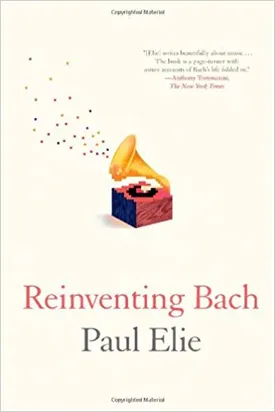Reinventing Bach by Paul Elie
Paul Elie’s Reinventing Bach illustrates how changing interpretations of music can impact not just our appreciation of the work, but its potential reach and influence in our lives. Through the story of Johann Sebastian Bach, this book illuminates how an artist’s music can, over time, inhabit different forms, at different levels, for different purposes and for different audiences, ranging from the traditional to the modern.
This exploration begins with the life of Bach. Elie tells the story of a man who, though known in history mostly as a composer and performer of baroque music, was, in his time, a true master at creating art for a variety of influences and purposes. This includes more religious works, concertos and sonatas, as well as arrangements of traditional songs and dances, cantatas and other pieces meant to please certain tastes and ideologies. All were rooted in the same passion and technical skill that Bach demonstrated in each of his projects.
The book goes on to describe how Bach was buried in an unremarkable way, and his music and legacy took many years to appreciate. Not until the Romantic period of the 19th century did Bach’s music receive real attention, and even then there was disagreement and debate over the relevance of his music in the present era. People argued over Bach’s religious commitment to his music versus the “musical mathematics” of his approach as well as the influence of other composers on his works.
However, as time passed and new generations of thinkers came to study his works, a different version of Bach emerged. No longer defined by his history, many saw Bach as a universal figure. It was not just that his music could provide a spiritual experience regardless of belief, but the potential to inspire new ideas, a continual development of classic forms, and the ability to span centuries, cultures and geography. This realization has let to a “reinvention” of Bach, with his music found in places traditionalists would have never imagined. From cellist Yo-Yo Ma, to hip hop producers, to famous orchestras, to Tuvan throat singers, Bach’s music has been reinterpreted and applied in different contexts.
The best example of this reinvention perhaps is conductor and harpsichordist Joshua Rifkin and the St. Matthew Passion. This work of Bach was interpreted anew by Rifkin with simplified accompaniments and a reduced cast, making it accessible to contemporary audiences in ways that the original could not have been. This reimagining of Bach’s works, in Elie’s opinion, represents a triumph both in music and life as it can illustrate the potential for us all to contribute to new ideas and thinking.
Reinventing Bach is a must-read for any music lover. Its thoughtful approach to exploring a timeless talent offers an appreciation for the old and the new. Interspersed with stories of Bach and his influence, we get insights on how classical forms can be reinterpreted to deepen our appreciation of a work, creating impact throughout generations and cultures in the form of music. Paul Elie presents a captivating story of the expanding reach of an artist, his music and his legacy.

